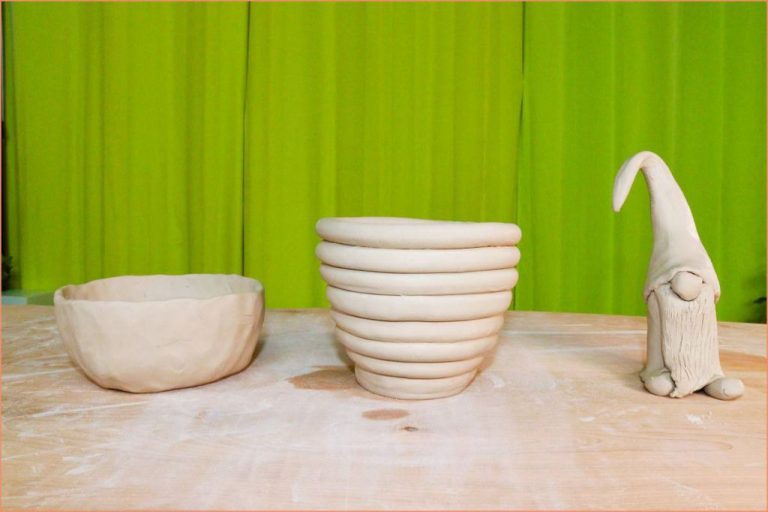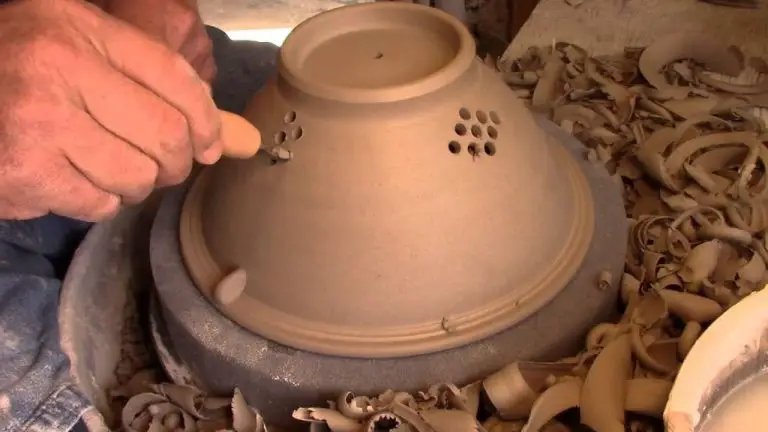How Hot Do Electric Kilns Get?
An electric kiln is a heating device used to fire ceramics, glass, enamel work, and other heat-workable materials. It uses electricity to generate high temperatures inside an insulated chamber.
Most electric kilns designed for ceramics can reach over 2,300°F (1,260°C), with some specialized models going up to 2,600°F (1,430°C) or higher. These ultra-high temperatures allow the kiln to vitrify clay and ceramic materials. Kilns designed for glass or enamel work can exceed 2,300°F (1,260°C).
In this article, we’ll explore the maximum and typical temperature ranges of electric kilns, how the heating elements and insulation enable kilns to reach such high temperatures, different kiln designs, temperature control methods, and safety considerations when operating an electric kiln.
Purpose of High Temperatures
Kilns heat materials like clay, glass, and metal to extremely high temperatures for various purposes. The main reasons kilns reach such high heat are to harden clay, melt glass for fusing, and sinter metal or ceramic powders into a solid mass.
Clay is hardened through the firing process, which allows the silica in the clay to fuse and become less porous. Typical firing temperatures for clay range from about 1700°F to 2300°F, depending on the type of clay body used. Higher temperatures result in harder, less permeable clay with higher vitrification. Glazes on ceramics also melt and fuse to the clay body during firing, creating a glassy coating.
In glass fusing, powdered glass is heated to temperatures between 1300-1480°F, causing it to soften and fuse together into a solid shape. Higher temperatures up to 1500-1700°F can be used for slumping fused glass into or over a mold.
For sintering metals or ceramics, temperatures of over 2000°F are often required to fuse the powder particles together through diffusion bonding. This creates solid metal or ceramic parts from powders.
So in summary, kilns allow heating of clay, glass, and other materials to customize hardness, fusion, and sintering through precise high temperature control. Firing temperatures are matched to the specific material and desired material properties.
Maximum Temperatures
Electric kilns are capable of reaching very high maximum temperatures, typically in the range of 2300°F to 2700°F (1260°C to 1480°C) (1). However, the maximum temperature depends on several factors:
– Kiln design – Small hobby kilns may only reach 2000°F, while large industrial kilns can exceed 3000°F.
– Heating elements – The type, gauge, and wiring of the heating elements affects how much heat they can generate.
– Insulation – Thicker insulation allows kilns to retain more heat and reach higher temperatures.
– Electrical supply – The voltage and amperage available to the kiln determines how much power it can draw.
Higher temperatures require more power and more robust kiln construction. Customers should select a kiln rated for the desired maximum temperature for their needs.
Safety is also a concern at extreme temperatures. Kilns should be placed away from combustible materials and wired properly. Ventilation is important as fumes can be released. Operators should wear protective equipment when loading/unloading hot kilns (2). Monitoring temperature controls is critical to avoid overfiring.
With proper precautions, electric kilns allow reaching the high temperatures needed for vitrification and glaze chemistry while avoiding the risks of direct-fired methods.
(1) https://kilnfrog.com/blogs/frogblog/kiln-temperatures
(2) https://www.soulceramics.com/pages/guide-to-kiln-temperature-ranges-for-pottery
Typical Temperature Ranges
Electric kilns are capable of reaching a wide range of temperatures depending on the type of clay or glaze being fired. There are three main temperature ranges:
Low-fire clay and glazes typically fire between 1700-2100°F (900-1150°C), or cone 04-06 according to the Orton cone chart. These lower temperatures work well for earthenware clays which vitrify at lower temperatures. Glazes in this range produce brighter colors and more surface effects compared to higher temperatures.[1]
Mid-range stoneware clays and glazes fire between 2124-2264°F (1162-1240°C), corresponding to cone 6-10. This is the most common temperature range for stoneware pottery and achieves partial vitrification of the clay body. Glazes fuse smoothly and flowing at these temperatures.[2]
High-fire porcelain clays and glazes require temperatures between 2282-2345°F (1250-1285°C) or cone 9-11. Porcelain clays become fully vitrified and translucent at these high heat levels. Glazes reach a full melt and become very smooth and glass-like.[3]
Heating Elements
Electric kilns use heating elements that generate high temperatures that are needed for firing ceramics, glass, or metal. The heating elements consist of high resistance wire, typically made from materials like Kanthal or Nichrome, that is shaped into coils. When an electrical current is passed through the coils, the electrical resistance causes the coils to rapidly heat up. According to Duralite[1] , a leading manufacturer of kiln heating elements, their Universal Kiln elements can reach temperatures up to 2300°F.
The typical lifespan of a heating element in an electric kiln is 1-2 years, depending on frequency of use. The elements will degrade over time and eventually burn out, at which point they need to be replaced. It’s important to periodically inspect elements for signs of corrosion and uneven heating that indicates nearing end of life. Replacing elements before failure occurs will prevent damage to the kiln. New heating elements tailored for specific kiln models are readily available from companies like Duralite and can be easily installed by the kiln owner.
[1] “UNIVERSAL-KILN TYPE HEATING ELEMENTS.” Duralite, https://duralite.com/shop/kiln-replacement-elements/replacement-heating-elements-forkilns/. Accessed 4 Mar. 2023.
Insulation
Proper insulation is crucial for electric kilns to retain heat and function efficiently. Kilns are typically insulated with firebrick or ceramic fiber blanket. Firebrick is made from clay and sawdust fired at high temperatures, making it highly resistant to heat. Ceramic fiber blanket, also called ceramic fiber insulation, is made of spun ceramic fibers and can withstand temperatures up to 2300°F. It is flexible and rated on thickness and density.
Insulation reduces heat loss so the kiln can reach and maintain high firing temperatures using less energy. Good insulation also protects the kiln elements and outer kiln surface from overheating. Insulation materials like firebrick or ceramic fiber blanket withstand the high temperatures inside kilns, which can reach over 2300°F during firing.
Kilns designed for pottery, glass fusing, or other high temperature applications require insulation that can withstand repeated heating cycles at minimum 1400°F. High quality insulation maintains performance over time with minimal shrinkage or decomposition.
Kiln Design
The shape and size of an electric kiln can impact its heating efficiency and temperature distribution. Kilns are often cylindrical or square in shape, with sizes ranging from small tabletop models to large industrial kilns. The shape affects heat circulation, as the curved walls of a cylindrical kiln promote even heating, while the flat walls and corners of a square kiln can create hot spots. Smaller kilns heat up more quickly but may not accommodate larger pieces. Larger kilns require more power and insulation but offer greater capacity.
Most electric kilns are single chamber, with the heating elements surrounding a single interior space. Some larger kilns have multiple chambers separated by walls, allowing firing at different temperatures. Multi-chamber kilns require more complex controls and take longer to fire. The single chamber design has the advantage of even heating throughout one space. Proper ventilation and placement of heating elements ensures heat is distributed evenly in all areas.
Kiln design focuses on factors like shape, size, and chamber layout to optimize temperature distribution and capacity while minimizing energy use. Cylindrical shapes and single chambers promote the most uniform heating. Larger kilns allow more capacity but need more power and insulation. Overall kiln design impacts the efficiency, capacity, and temperature consistency during firing.
Source: https://www.instructables.com/Homemade-Electric-Kiln/
Temperature Control
Accurate temperature control is critical for firing clay and glazes properly in a kiln. Electric kilns mainly rely on three types of controllers – thermocouples, PID controllers, and programmable controllers.
Thermocouples are temperature sensors made from two dissimilar metals joined at one end. They produce a small voltage proportional to the temperature difference between the hot junction and the lead wires. This allows the temperature inside the kiln to be continuously monitored. Various types of thermocouples are used based on the maximum temperature needed.
PID (proportional-integral-derivative) controllers use a control loop feedback mechanism to regulate temperature. The controller compares the thermocouple reading against the target temperature and adjusts power to the heating elements accordingly. PID controllers require tuning specific to the kiln for optimal performance. Popular PID controller models include those made by Orton, Skutt, and Paragon.
Programmable controllers allow users to create custom firing profiles with multiple segments. Ramp rates, target temperatures, and hold times can be precisely set. Programmable controllers offer the most flexibility and control over the firing process. Many standalone and integrated controllers now include programming capabilities.
Safety
Operating an electric kiln safely requires proper installation, ventilation, and monitoring during firing cycles. Electric kilns can reach extremely high temperatures, so they must be installed correctly and operated with caution to avoid injuries or damage.
According to Soul Ceramics (https://www.soulceramics.com/pages/kiln-safety-tips), kilns should be installed with at least 12 inches of clearance on all sides and nothing combustible above the kiln. Proper ventilation is also critical – fumes must be able to escape through a chimney flue or vent hood. Operators should never leave a kiln unattended once firing has started.
The Skutt Kiln Company (https://skutt.com/skutt-resources/resources-just-for-you/architectural-specifications/kiln-safety/) advises checking that heating elements are in good condition before each firing. In addition, kilns should be shut off immediately if odd smells or excessive smoke are noticed. Firing chambers should only be accessed once fully cooled to avoid burns.
With proper installation, ventilation, and monitoring, electric kilns can be safely operated at the high temperatures needed for pottery, glasswork, and other projects requiring extreme heat.
Conclusion
In summary, electric kilns are capable of reaching extremely high temperatures, typically in the range of 1500-2300°F for ceramic firing. Factors like heating elements, insulation, and kiln design all affect the maximum temperature. While high heat is necessary for processes like vitrification and glaze chemistry, proper use and safety precautions are critically important.
Achieving the optimal temperature for your application takes knowledge and experience. Ramping up and down at appropriate rates prevents defects like cracking. Monitoring cone packs inside the kiln provides an indicator of when target temperatures are reached. Carefully controlling the firing schedule results in beautifully finished ceramic ware.
Kilns allow modern artists and hobbyists to work with clay in ways that were previously not possible without high temperature firing. However, their extreme heat requires vigilant safety measures. With proper care and firing techniques, electric kilns are an indispensable tool for ceramic arts.


